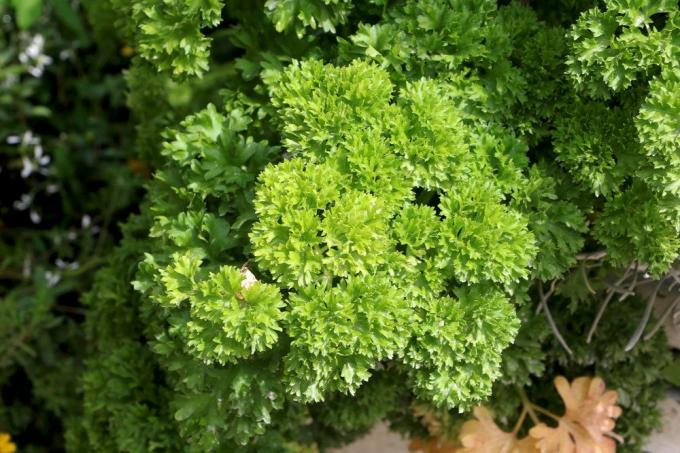
table of contents
- Parsley with blossom
- Flowers in the second year
- Harvest all year round
Even the ancient Romans knew to appreciate the effect of the aromatic herbs. The parsley (Petroselinum crispum) is still one of the most commonly used culinary herbs. It is used to refine soups, sauces and meat and fish dishes. Cultivation is easy not only in the home garden, but also on the windowsill, balcony or terrace. The harvest can take place almost all year round, but is the herb also edible when it is in bloom?
Parsley with blossom
Flowers in the second year
Most herbs can still be harvested after they have bloomed. But what about the parsley? Can fenugreek, as parsley is also called, still be used in the kitchen when it is blooming?
The flowers appear in the second year after planting or sowing. They stand on 90 to 120 centimeters long and thicker flower stalks. The inflorescence appears in the form of flattened umbels and consists of
- many small, star-shaped flowers
- Petals white or greenish-yellow to tinged reddish
- inwardly directed petals
- a few bracts
- Insect pollination
- green-gray, egg to pear-shaped fruits (seeds)
The herb blooms from June to July. During and after the appearance of the flower umbels, the consumption of the aromatic herb is harmful to health.
Note: The parsley is no longer edible, let alone edible!
The proportion of poisonous apiol contained in the plant parts increases. The concentration of other essential oils is also exceptionally high. The leaves and other parts of the plant are practically poisoned. It should therefore no longer be used in food. The same applies to decoration purposes. It is similar with woodruff. Here the coumarin content increases drastically.

It doesn't help if the flower stems are removed regularly, because they grow again gradually and the remaining parts of the plant contain the poisonous apiol in high levels anyway Concentration. Care should also be taken with the egg-shaped seeds. This also contains a very high proportion of the poisonous apiol and other essential oils. It is therefore more advisable to harvest enough leaves before flowering. However, the flowers should remain, because they offer like other flowering herbs, for example dill, sage, or thyme Lovage Food for bees. After the plant has withered, it can be torn up and disposed of on the compost.
Note: Apiol in very high concentrations can lead to allergic reactions, cramps in the digestive tract, but also to liver and kidney damage. Pregnant women and those with kidney disease in particular should avoid the consumption of blooming parsley. This active ingredient can trigger contractions in the uterus and lead to premature births or even miscarriages.
Harvest all year round
It is generally known that herbs in particular are most aromatic shortly before flowering, as a relatively high proportion of essential oils is then present. This also applies to the parsley. It is therefore advisable to harvest a lot of leaves before it flowers. To do this, simply cut off the stems with the leaves. This can be done close to the ground. Usually the herb grows back quickly. However, it is important that the heart leaves remain standing with a slightly thicker stem so that new shoots appear again and again. In the first year, the harvest on the windowsill can take place all year round and in the garden, depending on the weather, from March to October. In the second year, however, only until shortly before flowering in May to June. The use can
- done fresh
- Addition shortly before the end of the cooking time
- Shelf life in the refrigerator 3 to 4 days
- well suited for freezing
- wash the stems
- carefully shake dry
- then finely chop
- Packed in foil bags or small containers

Note: In contrast, the flowers of various herbal plants such as chives, borage or oregano can be eaten or used for decoration. They are very tasty.
